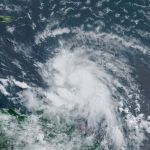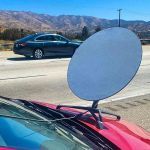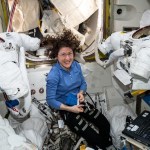Dominique Luchart's Blog, page 578
July 2, 2021
Hurricane Elsa, 1st of season, could hit Florida next week, ,

The first hurricane of the 2021 season, named Elsa, formed Friday morning (July 2), and is on track to impact islands in the Caribbean Sea and possibly Florida, according to the National Hurricane Center (NHC).
Elsa — currently a Category 1 hurricane, with wind speeds between 74 and 95 mph (119 and 153 km/h) — is the earliest fifth named Atlantic storm on record, CNN reported. The four names on the 2021 ahead of Elsa (Ana, Bill, Claudette and Danny) were given to tropical storms that didn’t reach high enough wind speeds to qualify as hurricanes.
With such an early start, it’s possible that the 2021 hurricane season may rival that of 2020, which set a record with 30 named storms, beating the previous record holder of 28 storms named in 2005, according to the National Oceanic and Atmospheric Administration (NOAA). Of those 30 named storms of 2020, 11 made landfall in the United States.
Related: Hurricane season: How long it lasts and what to expect
If Hurricane Elsa reaches Florida next week, it could impact the part of the coast where the deadly Surfside condo collapsed, CNN reported.
“It is possible that this area could see tropical storm-force winds,” Florida Gov. Ron DeSantis said Friday, according to CNN. “Not guaranteed, but it is possible, and so our Department of Emergency Management is assuming that that will happen and making the necessary preparations to be able, obviously, to protect a lot of the equipment.”
[image error]
Here, the probably path of the storm center through Wednesday, July 7, 2021. (Image credit: NOAA)The “birth” of a hurricane requires two things: a weather disturbance, such as a thunderstorm, that pulls in warm surface air, and surface water that is at least 80 degrees Fahrenheit (27 degrees Celsius), according to NOAA. Such storms usually begin over the tropical ocean, where the seawater is hot enough and Earth’s rotation helps them spin. However, Elsa got its start farther east than only one other storm on record — a 1933 storm, Brian McNoldy, a tropical weather expert at the University of Miami, posted on Twitter, according to The Washington Post.
“This is truly bizarre (and 1933 was among the most active seasons ever),” McNoldy wrote in the tweet. Typically, storms form in the Caribbean and Gulf of Mexico, instead of east of the Lesser Antilles, as Elsa did, The Washington Post reported.
See more
Hurricane-level winds are expected to reach Windward Islands (Grenada, St. Vincent and the Grenadines, St. Lucia and Dominica) on Friday, and Haiti on Saturday (July 4), the NHC reported in a statement. It’s possible that hurricane conditions will affect the southern coast of the Dominican Republic and Jamaica on Saturday.
Meanwhile, heavy rainfall from Hurricane Elsa is forecast to hit the Windward Islands and southern Leeward Islands, including Barbados, on Friday. Puerto Rico, southern Hispaniola and Jamaica will also see rain this weekend, with possible flooding and mudslides, the NHC said. Strong winds, storm surges and rainfall are expected to impact parts of Cuba and possibly the Turks and Caicos, and the Bahamas this weekend.
RELATED CONTENT
—A history of destruction: 8 great hurricanes
—How hurricanes work (infographic)
—The 20 costliest, most destructive hurricanes to hit the US
Early next week, the Florida Keys and possibly the Florida Peninsula may experience a storm surge, wind and rainfall. “However, the forecast uncertainty remains larger than usual due to Elsa’s potential interaction with the Greater Antilles this weekend,” so it’s unclear at this point how Elsa will progress, and whether it will impact Florida and/or the Gulf Coast, the NHC said in the statement.
The Atlantic hurricane season lasts from June 1 to Nov. 30. According to 2020 research published in the journal Proceedings of the National Academy of Sciences, hurricanes are getting stronger as the world warms due to climate change.
Originally published on Live Science.
The post Hurricane Elsa, 1st of season, could hit Florida next week, , appeared first on NEWDAWN Blog.
Police ticket driver for sticking Starlink terminal on car’s hood, Joey Roulette

A California Highway Patrol officer stopped a Toyota Prius on Friday that had what looks like a Starlink dish fastened to its hood, the agency said in a Facebook post. The “visual obstruction,” sitting right smack in the middle of the car’s hood, landed the driver a ticket.
“Sir I stopped you today for that visual obstruction on your hood. Does it not block your view while driving?” an officer said, quoted in a post on CHP Antelope Valley’s Facebook page. The driver replied: “Only when I make right turns…”
The driver told the CHP officer that they were using the antenna to have Wi-Fi for a business they run out of their car, the agency told CNBC, which first reported on the traffic stop.
“Yes, it is in fact illegal to mount a satellite dish to the hood of your vehicle,” CHP’s Facebook post continued, citing a state law that bars other view-obstructions like objects hanging from a rear-view mirror, or poorly positioned GPS mounts. “It’s about safety folks. These are the real stories of the Highway Patrol. Safe travels everyone.”
Starlink, SpaceX’s fast-growing broadband internet service, is in the midst of an open beta period with over 70,000 users across 12 countries, according to its CEO Elon Musk. Many individual users are paying $99 per month for internet under that beta, using a $499 bundle of a self-aligning, large pizza-sized Starlink dish and Wi-Fi router.
SpaceX doesn’t have FCC approval to mount consumer Starlink terminals on moving vehicles yet, but the company has been testing such capabilities for months — mainly for commercial use-cases like shipping vessels, large trucks and passenger airplanes. Musk has said Starlink antennas, as currently designed, would be too powerful for individual cars.
“The antenna for that high-bandwidth, low-latency thing is sort of about the size of medium pizza, which you could put on a car, but I think is more bandwidth than you would really need,” Musk said during a January 2020 earnings call. “Technically, you could buy one and just stick it on the car.”
Not connecting Tesla cars to Starlink, as our terminal is much too big. This is for aircraft, ships, large trucks & RVs.
— Elon Musk (@elonmusk)
The post Police ticket driver for sticking Starlink terminal on car’s hood, Joey Roulette appeared first on NEWDAWN Blog.
REvil ransomware attacks systems using Kaseya’s remote IT management software, Richard Lawler

Just in time to ruin the holiday weekend, ransomware attackers have apparently used Kaseya — a software platform designed to help manage IT services remotely — to deliver their payload. Sophos director and ethical hacker Mark Loman tweeted about the attack earlier today, and now reports that affected systems will demand $44,999 to be unlocked. A note on Kaseya’s website implores customers to shut off their VSA servers for now “because one of the first things the attacker does is shutoff administrative access to the VSA.”
News Flash: cybercriminals are a$$holes.
Keep all the Incident Response teams in mind this holiday weekend as they’re in the thick of it…again.
If you use Kaseya VSA, shut it down *now* until told to reactivate and initiate IR. Here’s the binary: https://t.co/NIuGJZW84p https://t.co/GSXPlOPjFt
— Chris Krebs (@C_C_Krebs)
According to a report from Bleeping Computer, the attack targeted six large MSPs and has encrypted data for as many as 200 companies.
At DoublePulsar, Kevin Beaumont has posted more details about how the attack seems to work, with REvil ransomware arriving via a Kaseya update and using the platform’s administrative privileges to infect systems. Once the Managed Service Providers are infected, their systems can attack the clients that they provide remote IT services for (network management, system updates, and backups, among other things).
In a statement, Kaseya told The Verge that “We are investigating a potential attack against the VSA that indicates to have been limited to a small number of our on-premises customers only.” A notice claims that all of its cloud servers are now in “maintenance mode,” a move that the spokesperson said is being taken due to an “abundance of caution.”
We are investigating a potential attack against the VSA that indicates to have been limited to a small number of our on-premises customers only. We have proactively shut down our SaaS servers out of an abundance of caution.
We are in the process of investigating the root cause of the incident with the utmost vigilance, we have:
a. Notified all of our on-premise customers to immediately shutdown their VSA servers
b. Shutdown our SaaS Servers
We have been further notified by a few security firms of the issue and we are working closely with them as well. While we continue to investigate the incident, we will update our customers (and interested parties) as we have more information.
Dana Liedholm – SVP, Corporate Communications Kaseya
Today’s attack has been linked to the notorious REvil ransomware gang (already linked to attacks on Acer and meat supplier JBS earlier this year), and The Record notes that, collecting incidents under more than one name, this may be the third time Kaseya software has been a vector for their exploits.
The post REvil ransomware attacks systems using Kaseya’s remote IT management software, Richard Lawler appeared first on NEWDAWN Blog.
Sony makes clear it will still sell PSP games on the PS3 and Vita stores, Ian Carlos Campbell

In March, Sony received widespread backlash for announcing plans to shut down the PS3 and Vita stores and remove the ability to purchase PSP games from both storefronts. The criticism led Sony to reverse course in part, promising to keep the PS3 and Vita stores open, but the company stayed committed to ending “PSP commerce functionality” on July 2nd. While it was unclear exactly what that meant at the time, Sony has shed a little more light on the situation: you’ll still be able to buy new PSP games on the PS3 and Vita stores, but you won’t be able to buy new DLC, according to the company’s UK and US support pages (via Kotaku).
Here are the three new updates Sony made to clarify things, including that it will remove the ability to make searches or download DLC from the PSP store on July 6th:
What does this mean for you?
When the PlayStation(R)Store for PlayStation(R)Portable (PSP) was previously closed in 2016, you were still able to perform searches and make in-game purchases. Starting July 6th, 2021, you’ll no longer be able to perform searches or make in-game purchases.
What about PSP content that you already own?
You’ll still be able to download your previously purchased PSP content. You can download your previously purchased PSP content onto your PSP by accessing the Download List on the device.
What about PSP content that is available for purchase on the PS3 and PS Vita stores?
You’ll still be able to purchase and play PSP content that is available on the PS3 and PS Vita stores. However, you’ll no longer be able to make purchases via the in-game store for PSP content.
All of this naturally only applies to games that were sold digitally, but it helps preserve some of the PSP’s history and back catalog, since the native PSP storefront shutdown in 2016.
In comparison to Microsoft, which uses backwards compatibility across multiple generations as a major selling point for the Xbox Series X, playing older games on Sony’s consoles can often be a bit more complicated than just popping in an old disc. The Playstation 5 currently plays most Playstation 4 games, but if you want to play games from older generations on Sony’s newest console, you’ll need to pony up for a Playstation Now subscription, which lets you play Playstation 3 and Playstation 2 games streamed from the cloud, or buy full price remakes of the classics.
For the PSP, there’s still a feasible way to buy games for the beloved handheld, at least for now — even it means purchasing the games from one of two stores on entirely different hardware.
The post Sony makes clear it will still sell PSP games on the PS3 and Vita stores, Ian Carlos Campbell appeared first on NEWDAWN Blog.
Another day, another WD security flaw, Mitchell Clark

After a security vulnerability led to some WD NAS owners having their data wiped, a new vulnerability has been discovered in more of WD’s devices (via KrebsOnSecurity). The vulnerability, discovered by security researchers Pedro Ribeiro and Radek Domanski, is seemingly present on Cloud OS 3 devices and not on the newer Cloud OS 5, which WD recently released as an update. The problem is that, according to Ribeiro and Domanski, many of WD’s users don’t like the new version. That’s because it’s missing certain functions and features that were available in Cloud OS 3. WD has said it won’t be updating Cloud OS 3 with security patches.
There’s also the possibility that some users won’t be able to upgrade to Cloud OS 5. According to WD’s supported devices page, the updated software isn’t available for the MyCloud EX2, EX4, or certain versions of the My Cloud and My Cloud Mirror.
If you own a device that can’t be updated to Cloud OS 5, WD’s advice is to upgrade to one that can. The other option, according to a statement WD gave to Comparitech last year, is to turn off remote dashboard access to the device.
The researchers found that they could get into a Cloud OS 3 device by remotely updating it with modified firmware. The firmware update functionality is meant to be accessible only to authenticated users, but they were able to get around that because the NAS seemingly has a user on it with a blank password, which they were able to use to authenticate in some cases.
Their version of the exploit allows them to carry out commands on the NAS, but other versions could be used for any number of nefarious purposes. Also, because the hack exploits the firmware update function, a hacker could purposefully or even accidentally brick the device. The researchers have built their own custom security patch, but it has to be re-applied to the device every time it reboots. You can see more details about it in a video they made explaining the exploit.
[embedded content]While the vulnerability found by the researchers seems especially egregious, it may not be the only one out there — WD’s post recommending people upgrade to Cloud OS 5 says that it defends against entire classes of attacks. With that in mind, if you own a device that can’t run the new OS, it’s probably time to think about an upgrade, either to one of WD’s new devices, or to another NAS option.
The post Another day, another WD security flaw, Mitchell Clark appeared first on NEWDAWN Blog.
Peacock premier tiers will stream the 2021 Stanley Cup games, Catie Keck

NBCUniversal’s streaming service Peacock will stream every remaining 2021 Stanley Cup Final match, just as the service’s parent company will stream the games on broadcast NBC.
The service announced this week that the matches would kick off with a stream of Game 3 between the Tampa Bay Lightning and Montreal Canadiens. The streaming coverage will cover up to five games and will be available through Peacock’s premium tiers, which cost $5 per month with ads or $10 per month to go ad-free.
The announcement marks a noticeable push by NBCUniversal to round out the sports programming on its marquee streaming service. In addition to coverage of Tour de France and Tokyo Olympics and Paralympics, among other sporting events, the service is also the exclusive home of WWE Network events, including the forthcoming SummerSlam.
Peacock may be the scrappy little guy in the room, but it’s sure offering a lot more niche sports coverage than many of its contemporaries. Your move, Paramount Plus.
The post Peacock premier tiers will stream the 2021 Stanley Cup games, Catie Keck appeared first on NEWDAWN Blog.
NASA wants to change the way it protects astronauts from radiation, ,

Astronauts face a constant specter of radiation, as particles streaming off the sun and high-energy cosmic rays constantly bombard their bodies.
Left unchecked, radiation can trigger all sorts of health issues, most notably boosting an astronaut’s danger of developing cancer. So, when NASA plans missions, the agency uses a radiation exposure cap to determine how long astronauts can stay in space. But that cap isn’t equal for all astronauts, and now, independent experts are backing NASA’s effort to change it.
Currently, NASA calculates that cap based on a risk estimate. The limit is the amount of total exposure that would give an astronaut a 3% higher chance of dying of cancer in the rest of their life, based on available data.
Related: Radiation poses a major obstacle to future Mars-bound astronauts
However, susceptibility to the cancers that radiation can cause varies with age and reproductive organs, so the limit doesn’t allow equal time in space. NASA’s women can’t spend as much time in orbit as NASA’s men, and younger astronauts can’t stay up as long as their older counterparts, who don’t have as many years left for cancer to develop. (Sex isn’t really binary, but such is the data available.)
NASA has previously considered changing this system to a cap that would limit all astronauts’ exposure to the risk limit as applied to the most vulnerable: a 35-year-old woman. Now, a committee of the National Academies of Sciences, Engineering, and Medicine has unveiled a report that supports NASA’s proposal.
In hard units, that’s a total of 600 millisieverts over a career with the agency. For comparison, a single chest X-ray at your doctor’s office gives you around 0.1 millisieverts, and you pick up around 3 millisieverts every year from Earth’s natural background radiation. Workers near Chernobyl’s ground zero in 1986 were showered with 6,000 millisieverts.
Meanwhile, a six-month stay on the International Space Station exposes an astronaut to between 50 and 120 millisieverts, according to the new report; more distant destinations like Mars carry greater exposures.
In effect, the proposed limit would expose younger astronauts and women to comparatively riskier amounts of radiation and reduce the amount of time that older astronauts and men can spend in orbit, according to the report.
NASA’s radiation standards were last updated in 2014. “A lot has changed since then, in terms of our understanding of radiation biology,” Dr. Carol Scott-Conner, a professor of surgeon at the University of Iowa who was on the NAS committee, told Space.com.
Many radiation exposure standards are based on historic studies of survivors from the atomic bombs dropped on Hiroshima and Nagasaki in 1945. Now, that’s being augmented by more recent data, such as that from workers in radiation-heavy industries like nuclear medicine and nuclear power.
The suggested change isn’t supported universally. “I think this change is problematic,” Francis Cucinotta, a radiation biologist at the University of Nevada, Las Vegas, who has previously worked with NASA, told Space.com. He calls the proposal akin to playing Russian roulette with female astronauts, placing them at extra risk from radiation exposure.
But Scott-Conner disagrees. “We agreed with NASA’s conclusion, that the best thing to do was set it according to the standard for the most vulnerable population, which is the 35-year-old woman,” she said. Furthermore, she said that NASA’s exposure limits are significantly lower than those of other space agencies.
However, Cucinotta thinks that focusing solely on cancer risk ignores other problems linked to radiation, such as heart disease and cognitive issues. He thinks NASA ought to look at more data before they make comprehensive changes. “I don’t understand why they’re doing it now,” he said. “There’s plenty of time to do research, this decade, for longer lunar missions or a Mars mission.”
The proposed changes come as NASA prepares to send astronauts beyond Earth’s orbit. The first Artemis program missions to the moon and back aren’t likely to expose their crews to much radiation. But longer spaceflights — for instance, months-long missions to Mars — would well surpass NASA’s limits under either system.
Short of far better radiation shielding, astronauts going to Mars would need to go through a waiver process. The report emphasizes that NASA should set up a clear and transparent framework for making that happen.
In the meantime, Scott-Conner said, scientists have plenty more to learn about how people react to the sort of radiation in space. “There’s a lot that’s different about surviving an atomic bomb and flying a mission to Mars.”
Follow us on Twitter @Spacedotcom and on Facebook.
The post NASA wants to change the way it protects astronauts from radiation, , appeared first on NEWDAWN Blog.
‘The Tomorrow War’ won’t win any awards, but it’s a watchable action romp (review), ,

Warning: spoilers ahead!
Amazon Prime has dialed its mighty marketing machine up to 11 for its new sci-fi blockbuster starring Chris Pratt, but how does it actually rate? Even from the trailer it was apparent that “The Tomorrow War” was going to sit somewhere near equivalent popcorn presentations like “Battle Los Angeles,” “Battleship” and “Independence Day” and that still rings true. And like those movies, this one also contains some nice ideas together with some cringeworthy cliches.
In the new movie, the world is stunned when a group of time travelers arrives from the year 2051 to deliver an urgent message, that 30 years into the future, mankind is losing a global war against a deadly alien species. The only hope for survival is for soldiers and civilians from the present to be transported to the future and join the fight.
Among those recruited is high school teacher and family man Dan Forester (Chris Pratt), but in disappointing fashion, we learn through exposition — in the first lines of the movie — that underneath his everyday cardigan-wearing exterior is the mind and body of a former U.S. Army Special Forces soldier, because of course.
Want to try Amazon Prime? Sign up for a free 30-day trial here.Subscribe to Amazon Prime for $12.99 a monthPratt also played an ex-Navy SEAL in “Jurassic World.” Tom Cruise is an ex-Navy SEAL in “The Mummy” reboot. Vin Diesel is an ex-Navy SEAL in “The Pacifier.” Toby Stephens is former Special Forces in “Lost in Space.” In almost every action movie made in modern times, this cliched plot device indicates that the character has an especially impressive skill set.
The time travelers’ message, or “cry for help across time,” is delivered to the world during the FIFA World Cup final in Qatar, during the winter of 2022 — just 18 months from now — between Brazil and an unidentifiable team (probably a rights issue). The score is tied 3-3, with about 90 seconds or so left. When suddenly, in front of the 80,000-seat Lusail Stadium, a time portal opens on the pitch. With the whole world watching, a team of soldiers from the future emerges through a cloud of sparks and smoke.
The World Cup is being played in the winter because of the extreme heat during the summer, and Forester is outside in his high school-issue cardigan, suggesting he’s somewhere warm-ish (we assume it’s Florida, based on several references to Miami’s football team, the Dolphins). It’s evening, and Forester is with a group of friends and family watching the game, which would also be played during the evening in Qatar, but the U.S. East Coast is eight hours behind Qatar Time, so that doesn’t quite add up.
[image error]
The thing is, games aren’t scheduled to be played at 4 a.m. in Qatar in the 2022 FIFA World Cup… (Image credit: Amazon Studios)Minor grumbles aside, the film does get into the action pretty quickly — in under eight minutes, in fact. However, to accomplish this, the movie skims over one or two pretty major plot points in a blink and you’ll miss the summary montage. First, we learn that soldiers were recruited before the situation became so dire that civilians were needed. Still, it seems that the world’s armed forces weren’t able to defeat the alien invaders. We also learn why December 2022 was chosen as the point to return to.
It could be said that the whole world was watching the tournament final on television, so the message could effectively be transmitted around the globe. But then why not wait another eight years or so, when weapons technology might be just that little bit more advanced? And what about bringing military hardware to the future? Squadrons of ground support aircraft like A10s or even tanks?
One significant issue with time travel that’s guaranteed to be ignored in every movie or TV show that incorporates it is that the planet Earth moves through space. Take “Back to the Future” for example, Marty McFly travels from the car park of Twin Pines Mall on Oct. 26, 1985 to the Peabody farm on Nov. 5, 1955, in essence the same location. But he traveled in time — not in space — so the fact that the dates are different means that the Earth was in a different place in its orbit. To all intents and purposes, Marty should have appeared in the middle of space, simultaneously freezing and suffocating and destined to continue traveling through the cosmos by way of inertia for all eternity because Southern California was 16 million miles (26 million kilometers) further around the sun.
[image error]
“No way was he offside! Aw, come on ref, what, you need glasses?! He was clearly behind him!” (Image credit: Amazon Studios)Incorporating this fact could have meant colossal kudos being heaped upon this movie, but sadly, it was not to be.
We learn that to “qualify” to be sent 29 years into the future, you must have died, at some point in the future, before 2051, to prevent a paradox. This is a nice touch and if you’ve ever seen the not-terrible late-80s sci-fi thriller, “Millennium,” starring Kris Kristofferson and Cheryl Ladd, then you know how bad a paradox can be for just about everyone.
The legendary J.K. Simmons appears as James Forester, Pratt’s father, but sadly his primary purpose is to provide exposition and set up and a predictable reconciliation later in the picture. Jasmine Mathews plays Lt. Hart, the soldier so prominent in the trailer who actually announces to the world that it faces imminent annihilation. Sadly though, after her memorable arrival, we hardly see anything of her, definitely a missed opportunity there.
The team deploys and is immediately met with disaster as instead of falling just 10 feet (3 meters) or so to the ground when they emerge through time, they are mostly plummeting to their death from what appears to be hundreds of feet up. Thankfully, there’s a swimming pool, so everyone with a speaking role so far in the movie makes it more or less unscathed.
[image error]
Thankfully, everyone who had a speaking part in the movie up until now makes the time jump without dying. (Image credit: Amazon Studios)What follows is almost a tribute to many sci-fi films of the past as familiarities, either in story set pieces or even production design, crop up on a regular basis. Even the nasty aliens, called “white spikes” have unquestionably been influenced by the “mimics” of “Edge of Tomorrow” although thankfully there’s only a passing resemblance and not a direct lift like we saw in with the “fear demon” in “Star Trek: Discovery” Season 3.
Director Chris McKay said in an interview as part of the movie’s promotion, “Obviously, there’s a couple of high watermarks as far as alien designs, it’s whether it’s the Xenomorphian alien, or whether it’s the Predator, but then there’s everything else. It’s trying not to get close to that, but also trying to find something that serves the purpose of the film and was memorable and on its face horrifying.”
Throughout the movie, there are subtle and not-so-subtle references to “Starship Troopers,” “The Thing,” “Edge of Tomorrow” and even “World War Z.”
[image error]
Yikes! If he’d landed on that, it would’ve been game over. You think he’d put it in a Peli case or something. (Image credit: Amazon Studios)Since each civilian is effectively dead anyway, some characters — and in particular Edwin Hodge’s character, Dorian — give absolutely everything to the fight. Perhaps this was an intentional philosophical commentary on the mindset of anyone who’s faced combat, or perhaps this was simply incorporated to give his character an excuse to be particularly efficient in exterminating those pesky extraterrestrial invaders.
Along the way, some reasonably predictable twists are revealed, which we’re pretty sure that allowing the characters themselves to hear about would actually cause a paradox in and of itself. Plus, some father-daughter parental issues are thrown into the mix, although thankfully, it’s not on the same, ridiculous, off-the-chart scale as “Interstellar.”
The action switches in the second act to a seemingly impenetrable fortress at sea, protected by not one. It has two defensive perimeters, plus minefields and air cover, but still falls. It seems no one in the future was able to predict how these creatures could overwhelm such a facility, which is a shame as it seems fairly obvious. And then, just as all seems lost and the way back to 2053 is destroyed, the final act of the movie starts with a twist that’s equally as absurd as the “they’ve always been here” slant on Steven Spielberg’s “War of the Worlds.”
[image error]
Almost certain that an American research team in Antarctica found something similar back in 1982. (Image credit: Amazon Studios)Had Pratt’s character seen “Frequency” or at the very least “Bill & Ted’s Excellent Adventure” he might have been able to come up with at least one other alternative plan of action. Sadly, the whole final act feels rushed and tacked on. The dialogue is kept to exposition only, the tone of the film has completely changed and is suddenly incorporating more comedy and of course we have the “hooray-for-science” element thrown in for good measure. There’s even a climate change message that feels like it’s been hastily stuck on with Scotch Tape.
The casting choices are solid and along with those we’ve already mentioned is Yvonne Strahovski, who has a really strong Adrianne Palicki vibe going. However, these talented actors aren’t given a lot to work with and so we never really become fully invested in what happens to them.
[image error]
Thank goodness for the power of science and in particular, the study of volcanoes. Call your local college now. (Image credit: Amazon Studios)It’s an usually long offering for a popcorn flick at 2 hours and 18 minutes and it starts off well, but before long it begins to descend into absurdity and once you’re past the halfway point it becomes a little bit of a struggle. Sure, you want to know what happens, but you’re probably not going to bother pressing pause when you go to the refrigerator to get another can of beer.
Watching “The Tomorrow War” reminds me of my first “screenplay” I wrote in the sixth grade where I basically ripped off every scene and set piece from my favorite sci-fi movies and TV shows and combined everything. The characters fought off huge walking machines on an ice planet, then there was a big battle in space with a giant fighting robot made up of three spaceships that connected together, before finally crash landing on a barren, desert planet where apes were the dominant civilization. I seriously doubt any studio executive would’ve even read past the first page, but now I’m beginning to wonder if I still have that lying about somewhere.
Follow Scott Snowden on Twitter. Follow us on Twitter @Spacedotcom and on Facebook.
The post ‘The Tomorrow War’ won’t win any awards, but it’s a watchable action romp (review), , appeared first on NEWDAWN Blog.
New Qualcomm CEO sees former Apple execs as key to beating M1, Mitchell Clark

Qualcomm’s new CEO, Cristiano Amon, has big plans for competing with Apple when it comes to laptop performance, thanks to the ex-Apple employees Qualcomm brought on when it acquired Nuvia earlier this year. He told Reuters that he believes Qualcomm could make the world’s best processor, which would require designing a chip better than Apple’s M1.
Before assuming his new role as CEO, Amon was head of Qualcomm’s semiconductor division and was in charge of the company’s acquisition of Nuvia for $1.4 billion. The startup was founded by three former Apple engineers who specialized in chip design and worked on Apple’s A-series SOCs. Those founders joined Qualcomm, and it’s apparent now that they’ll be focusing on making chips for consumer computers (though the company wouldn’t turn down the chance to license its tech to data centers, according to Reuters). Qualcomm hopes to start selling Arm laptop chips, powered by Nuvia’s designs, next year.
Amon also hopes to use the company’s experience in making 5G chips and smartphone processors to help provide a better laptop experience, by building 5G connectivity into its laptop-focused CPUs. Adding 5G, or any cellular compatibility at all, is something that Apple hasn’t done yet for its M1 Macs, despite demand from some (though it’s M1-powered iPad Pro has a 5G option).
It’s safe to say that if Qualcomm wants to become a dominant player in powering laptops like it is in the smartphone market, it has a lot of work to do. While Microsoft does use Qualcomm-designed chips in its Surface Pro X (which made an appearance at the Windows 11 event), the list of Windows PCs with Qualcomm inside isn’t a long one. It’s also unlikely that Intel is planning on just letting Arm take over the laptop space without a fight — the company is working on hybrid CPUs that, like Arm, mix high-power and efficiency-focused cores to provide better battery life, but using an x86 architecture.
Amon also talked to Reuters about challenges and opportunities the company faces due to sanctions in China and about the company’s struggles to become a household name like Intel or AMD.
The post New Qualcomm CEO sees former Apple execs as key to beating M1, Mitchell Clark appeared first on NEWDAWN Blog.
Lordstown Motors is now being investigated by the Justice Department, Sean O’Kane

The Department of Justice has opened an investigation into troubled electric vehicle startup Lordstown Motors, which is backed by General Motors and went public late last year but has yet to get its pickup — the Endurance — into production, according to The Wall Street Journal. It’s the second official probe into the startup, as the Securities and Exchange Commission opened an investigation earlier this year into Lordstown Motors executives’ misleading claims about how many preorders it had logged for the Endurance.
The new investigation, which is being run by the US Attorney’s office in the Southern District of New York, comes just weeks after Lordstown Motors’ CEO and founder was pushed out following a law firm’s probe into those misleading claims. The startup’s chief financial officer and other executives and personnel close to the founder were also let go at that time.
“Lordstown Motors is committed to cooperating with any regulatory or governmental investigations and inquiries,” a representative for the startup said in a statement. “We look forward to closing this chapter so that our new leadership – and entire dedicated team – can focus solely on producing the first and best full-size all-electric pickup truck, the Lordstown Endurance.”
It’s unclear exactly what the Justice Department is examining, though SDNY often focuses on financial crimes and allegations of fraud. The DOJ is also investigating electric trucking startup Nikola, and the SEC has opened a probe into fellow EV startup Canoo. The press office for the SDNY did not immediately respond to a request for comment.
Steve Burns, the founder, started Lordstown Motors in 2019 after leaving his previous startup, another electric vehicle company called Workhorse. He essentially founded Lordstown Motors in order to buy a recently shuttered plant in Lordstown, Ohio where GM once built the Chevy Cruze. GM also took a stake in the company.
The purchase — and the startup itself — received praise from the Trump administration. Then-President Donald Trump said Lordstown Motors buying the factory was “GREAT NEWS” for the state, and later featured the startup at a White House event. Former Vice President Mike Pence even appeared at the Endurance reveal event in June 2020.
Buying the GM factory was supposed to give Lordstown Motors an edge over other startups that are building their own factories. Burns also found one with the truck, too, as he licensed intellectual property for an electric pickup that Workhorse had developed but never put into production — a deal worth millions of dollars for his former company.
In 2020, Lordstown Motors was one of a number of electric vehicle startups that went public by merging with a special purpose acquisition company, a process that helped it raise $675 million. Afterward, Burns and the company touted that they had logged around 100,000 preorders for the Endurance in late 2020 and early 2021.
But in March, short-selling research firm Hindenburg Research published a report that accused Lordstown Motors of, among other things, faking some of those preorders, and sourcing some to fleet brokerage firms that couldn’t afford the number of vehicles they were supposed to buy. Burns initially pushed back hard, saying “there’s always haters” and quoting Taylor Swift’s “Shake it Off” to a local news outlet. Soon after, the company disclosed the SEC probe and launched its own review.
In May, Lordstown Motors admitted that it needed more money to survive and lowered the number of vehicles it hopes to produce by the end of 2021. It has also stopped work on its second vehicle, an electric van, and said that it only has enough funding to last until May 2022.
The review — conducted by a law firm with ties to Lordstown Motors — wrapped up in June. It confirmed that Burns and others had made misleading claims about the preorders, and he resigned as a result.
Lordstown Motors has since tapped another former Workhorse executive, Angela Strand, to serve as interim CEO. She is being paid $100,000 per month to serve in the role while the company hunts for a permanent replacement, according to a recent filing.
The post Lordstown Motors is now being investigated by the Justice Department, Sean O’Kane appeared first on NEWDAWN Blog.



